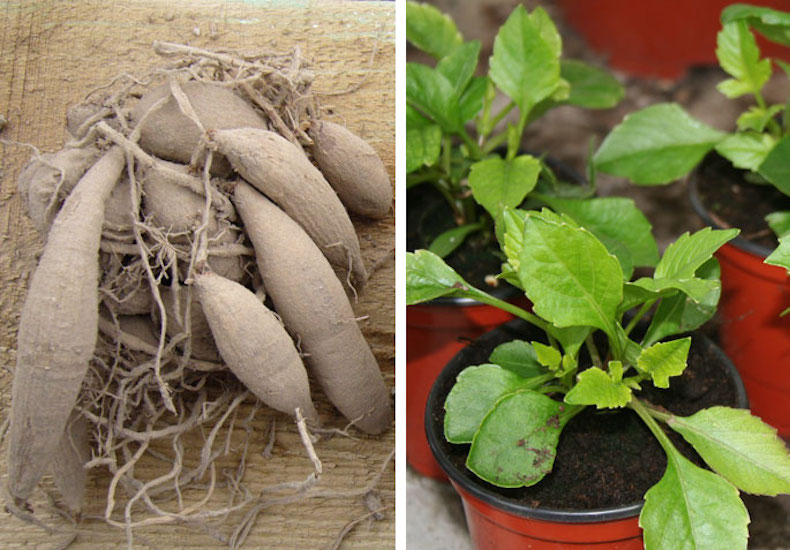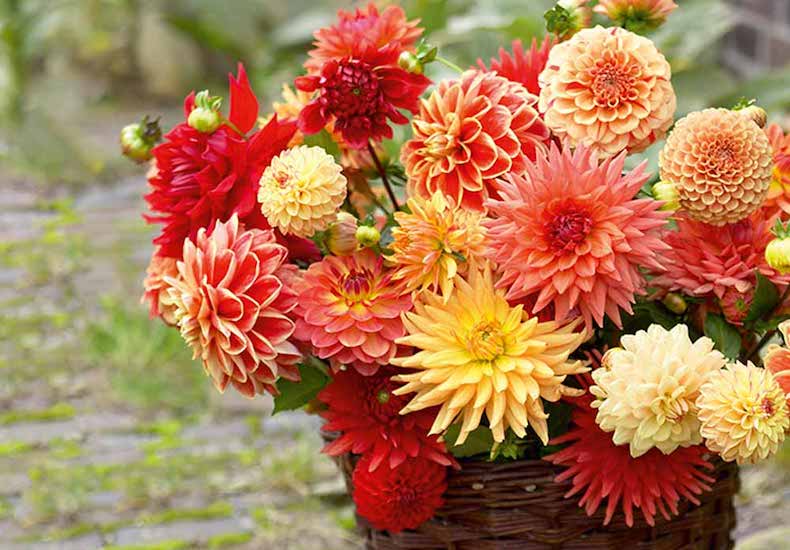How to grow dahlias

Dahlias add height, colour and dimension to your garden
Image: Shutterstock
Dahlias lend themselves to a broad swathe of garden styles from carefully coordinated colour schemes to the eclectic symphony of a traditional cottage garden. A diverse genus, they range from compact container varieties to tall feature plants for the back of the border. It's no surprise that they’ve experienced something of a renaissance in recent years.
Growing dahlias isn't as difficult as you might think - read on for top tips or browse our full range of dahlia tubers to choose your favourite varieties.
Should I buy dahlia seeds, tubers or plug plants?

Tubers or plug plants are easy ways to grow dahlias
Image: T&M
Dahlias can be raised from seeds, tubers or plug plants. Tubers are by far the most popular, and these mature, bare root plants are ready to go directly into the ground from mid-April, when the soil has warmed up a bit. Alternatively, they can be potted into large 3-litre pots and grown on in a frost-free greenhouse, before planting out into their final positions.
Plug plants are a little more delicate, requiring potting up and growing on in frost-free conditions during spring. They can be hardened-off and planted out in May once they’re well grown.
If you have greenhouse space or a bright windowsill then bedding dahlias are easily grown from seed. This is a cost-effective choice if you require large numbers of plants. Sow them from February to April in free-draining seed compost, maintaining a steady temperature of 18-20C. When they’re large enough to handle and have a well-established root system, transplant the seedlings into individual cells or small pots. Grow them on in warm conditions, repotting when necessary, until they’re large enough to be hardened-off and transplanted outdoors in late spring or early summer.
How and where to plant dahlias

The harmonising colour palette of 'Pink/Purple Pompon Mix' brings height and structure to borders
Image: Dahlia 'Pink/Purple Pompon Mix' from T&M/© Visions BV, Netherlands
Dahlias are half-hardy, so it's important to keep them protected from frosts. Once all risk of frost has passed, they can be acclimatised to outdoor temperatures over 7-10 days before being planted out into their final flowering positions. Choose a sunny spot in moist, fertile, well-drained soil. Prepare the soil by digging in plenty of well-rotted manure or compost and incorporate some blood, fish and bone fertiliser to feed the plants.
Dig a hole large enough to accommodate the rootball, ensuring that your plant sits at the same depth in the soil as it was in the pot. Tubers should be planted so that the stump of the previous year's stem sits just above ground level, with the 'sausage-like' tubers covered completely by the soil.
Taller varieties will almost certainly need staking with sturdy canes or narrow wooden posts to support their stems. It's a good idea to insert stakes into the planting hole before positioning the plant. This will avoid damaging the root system later on. Settle the soil after planting by giving it a good soaking with water.
At this stage, it's a good idea to put some slug protection in place. Use copper tape to protect container-grown plants. Dahlias planted directly into the soil can be protected using slug traps, pellets, or physical barriers with rough surfaces such as a mulch of bark chips, crushed eggshells or sharp grit.
How to get the best from your dahlia plants

In graduated shades of pink, the contrasting shapes of this mixed collection add interest and colour
Image: Dahlia 'Berry Sorbet Mix' from Thompson & Morgan
Here are a few tips to help you grow bushy plants with lots of healthy flowers:
- When your dahlia plants have 4 sets of leaves, pinch out the growing tip of each stem to encourage bushier growth.
- For the biggest blooms and strongest flower stems, select 5 to 7 main stems per plant and allow these to develop, removing all other side shoots that develop in the leaf axils below the main terminal bud.
- As your plants grow, gently tie them to their supporting stakes using soft garden twine.
- Feed and water your dahlias regularly throughout the growing season. Always water at the base of each plant, to avoid wetting the foliage.
- Once the flower buds begin to form, use a high potash feed every two weeks to encourage more buds to develop throughout the summer.
- Deadhead faded dahlia flowers ruthlessly to encourage more blooms to be produced.
How to store dahlias over the winter

Blooming until the first frosts, 'Orange/Salmon Mix' beautifully bridges late summer and autumn
Image: Dahlia 'Orange/Salmon Mix' from T&M/© Visions BV, Netherlands
In very mild areas, it may be possible to leave your dahlias in the ground over winter. Be sure that the soil is very free-draining and cover them with a thick layer of a dry mulch such as bark chips or straw. In colder areas, dahlia tubers can be lifted in autumn and stored over winter in trays of peat or sand. Just keep them in a cool but frost-free position. Here's how to go about it:
- In autumn, cut back the foliage and carefully lift the tubers from the ground with a garden fork.
- Place the tubers in a well-ventilated, dry location such as a garden shed or greenhouse and allow them to dry off before cleaning away any remaining soil.
- Trim away any fine roots, leaving just the main tubers.
- Place into seed trays of multi-purpose compost or dry sand, covering the tubers but leaving the crown of the plant just above soil level.
- Store in a cool frost free location. They won't need light at this stage, so a garden shed is fine but make sure that they are covered with fleece or a thick layer of newspaper on particularly cold nights.
- Check tubers regularly and throw out any that show signs of rotting.
- Replant in spring for another fabulous display!
With so many different colours, flower forms and sizes to choose from you may find it hard to narrow your choices down. Be bold and create an entire dahlia bed - don't be afraid to experiment with extraordinary colour combinations for an exotic riot of colour. For a more refined display, try picking just a few colour coordinated varieties that can be repeated through mixed borders.
Discover more dahlia advice, such as how to deter pests, by visiting our dedicated page of dahlia resources.

Written by: Sue Sanderson
Plants and gardens have always been a big part of my life. I can remember helping my Dad to prick out seedlings, even before I could see over the top of the potting bench. As an adult, I trained at Writtle College where I received my degree, BSc. (Hons) Horticulture. After working in a specialist plantsman's nursery, and later, as a consulting arboriculturalist, I joined Thompson & Morgan in 2008. Initially looking after the grounds and coordinating the plant trials, I now support the web team offering horticultural advice online.Sign Up For Exclusive Special Offers




© 2025 Thompson & Morgan. All rights reserved. A division of Branded Garden Products Limited.



